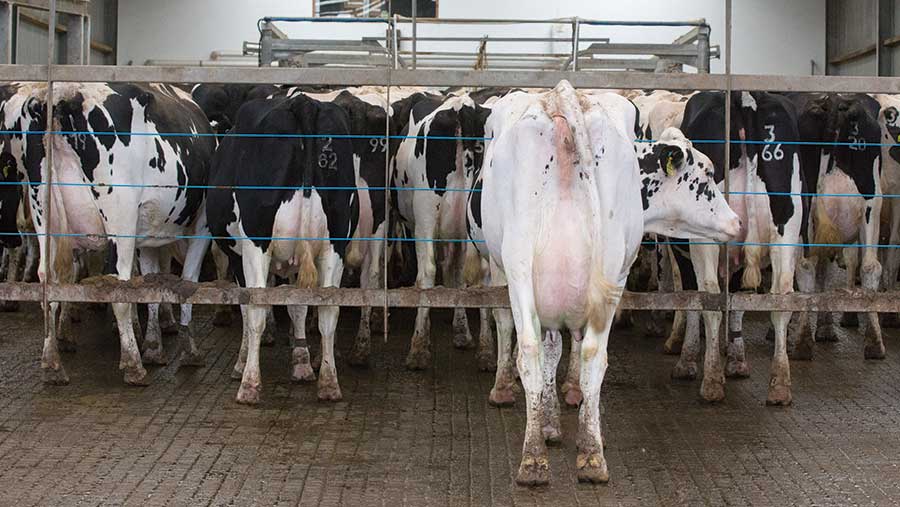7 ways to improve cow flow at milking
 © Tim Scrivener
© Tim Scrivener There’s nothing more frustrating than having to stop milking to go and push cows into the parlour, but have you ever stepped back and seriously asked yourself why cows are reluctant to come in?
According to Andy Dodd, dairy business consultant for the Farm Consultancy Group, cow flow at milking is an area that could be improved on more than half of dairy farms.
Poor cow flow can affect budgets and increase standing time – and therefore reduce feeding, drinking and lying times. These issues have poor implications for foot health, and for production.
Mr Dodd says that too often farmers mistakenly see putting on more milking units as the way to improve parlour throughput.
See also: 5 tests to assess your dairy herd’s welfare and comfort
Mr Dodd and Ian Ohnstad, milking technology national specialist for The Dairy Group, offer seven tips on how to maximise flow in and out of the parlour.
In numbers
- 1.5sq m a cow – target space allowance for each cow in the collecting yard
- 500 lux – the light levels needed in the parlour
- 2-3% – the advisable floor incline towards the parlour
1. Promote cow comfort
If milking is an uncomfortable experience it will make cows reluctant to come into the parlour.
Check vacuum levels, automatic cup remover (ACR) settings and milking liners and also think about the physical position of the cow in the parlour.
Milking larger-framed cows in a parlour designed 15 years ago for smaller animals can make standing uncomfortable.
This can lead to less-effective milk let-down and incomplete milk-out.
Actions:
- Providing a 2-3% rise in the floor towards the parlour can also encourage cows to face and move forwards.
- Installing rubber mats in a strip at the entrance to the parlour can draw cows towards the parlour.
- Installing rubber in the milking stalls, on exit and at any sharp turns can aid comfort and thus flow.
- Grooving concrete can also help cows move more confidently.
2. Think about stocking rates in the collecting yard
Cow flow typically becomes a problem on farms that have expanded and either extended or put in bigger parlours.
This is a particular problem when the size of the collecting yard has not changed and cow numbers have increased.
This means cows can be bunched up in the yard and unable to move easily through the group and into the parlour.
Cows will naturally stand with their heads down – so if a lot of cows have their heads up, this is a sign they are too tight.
Actions:
- Consider reducing the size of groups being brought to be milked to ease pressure or thinking about how the backing gate is being used.
3. Use the backing gate with care
If used too much, a backing gate can push cows too close together and reduce space per cow, reducing cow movement.
The key is to set the gate’s sensitivity and resistance, so that when it comes into contact with a cow it stops.
Linking the rear gate of the parlour to the backing gate also helps to stop the space per cow from being compromised.
Actions:
- For example, if one side holds 10 cows, the gate should move forward 15sq m to take up the target 1.5sq m of space per cow that has been freed up when the side fills up.
- Move the gate little and often.
- Put a bell on it so the cows can hear it coming and learn to move.
4. Ensure the parlour is well lit
Cows do not like moving from light to dark so it’s important to minimise shadows.
Actions:
- Walk the route to the parlour as a cow does and asses light levels (as well as any sharp bends).
- Ideally, the milking parlour should be lit at 500 lux.
- If cows have to walk through narrow doorways into the parlour, consider whether knocking the wall out is viable, so that cows can see straight through to where they need to be.
5. Reduce noise
Cows like routine and consistency so any loud, unusual sounds can upset flow, cause stress and reduce milk speeds.
Actions:
- Try to operate a quiet, calm milking environment.
- Avoid banging on metalwork or shouting at cows to move.
6. Consider stray voltage
Stray voltage – where the parlour is not earthed correctly and cows receive “pins and needles” from the parlour – can stop cows from coming into the parlour. It’s often quickly blamed by farmers for poor cow flow. However, there are a multitude of other factors that are more likely than this.
Actions:
- When in doubt, get a qualified electrician in to assess the parlour.
7. Think about exit design and space allowance
Ideally, cows should move in a straight line in and out of the parlour as sharp bends can compromise movement.
Actions:
- Ask yourself if you can eliminate sharp turns: can you take out the front wall of the parlour or maybe move where the AI stalls are?
- Ensure there is enough space on exit to cater for a whole side of cows (which may move slowly because of segregation or foot-bathing) so that the parlour is not backed up waiting for cows to move away.
- Having water troughs close to the parlour entrance or exit or a feed fence immediately on exit can also cause a jam in cow flow. Consider relocating to avoid a bottleneck.
